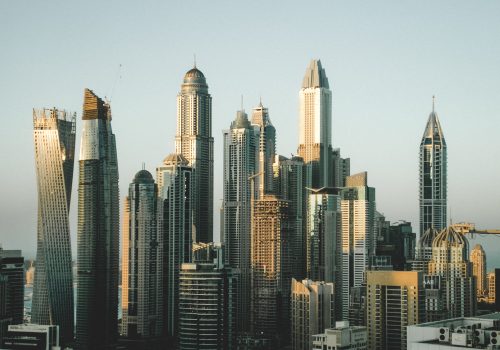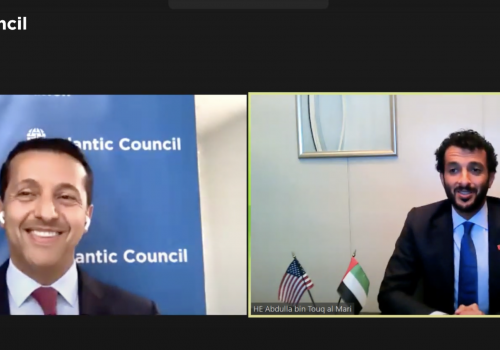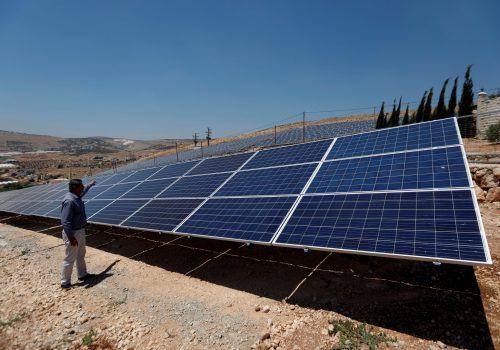The Middle East is a growing marketplace, not just a war zone
For the casual observer, the seemingly endless negative stories about the Middle East are reasons enough to avoid investing in the region. But a value investor knows that this can be the best time to buy. I spent fifteen years as a venture capital and growth investor in the Middle East, and what I saw in terms of economic opportunities and social impact deserves just as much attention as the security issues that tend to dominate US government and private sector engagement in that part of the world.
For many Americans, getting out of the Middle East and refocusing efforts on pressing matters at home is not just ideal but a necessity, especially given the economic meltdown brought on by the coronavirus pandemic. Looking at the situation in Yemen, Syria, or Iraq, it can be tempting to write off the Middle East as a place mired in intractable conflict and systemic problems. However, the region is vast and complex, and outsiders who do not fully understand its nations or peoples overlook the nuances of the nearly twenty countries that make up the Middle East.
The United States has built strong relationships in the Middle East through security, economic, and political engagement over the past decades. In turn, most regional governments are reliable allies and their people have a fondness for American innovation, creativity, and ingenuity. If the United States disengages at the very moment that the region is on the cusp of a significant transformation, American investments made in blood and treasure will go to waste and we will miss a significant strategic opportunity. The decline in oil prices since 2014 and the economic devastation due to the pandemic is causing the region’s leadership to consider and take bold, transformational action to redefine and diversify their economies. It is in the United States’ best interest to work closely with regional partners not only for the latter’s prosperity and stability but for ours as well.
The United States government, US corporations, and US investors should consider the following factors as they look to the region: the region’s potential to rival Europe in terms of being a marketplace for goods and services, the role the region plays in terms of keeping energy prices stable and reasonable, counterbalancing steps international competitors such as China are taking to expand influence in the region, and the fact that security without economic prosperity is fragile.
A growing market for US goods and services
The Middle East is composed of many countries across the wealth spectrum, from the poorest such as Yemen to the richest like Qatar. It boasts one of the youngest and fastest-growing populations in the world that is expected to reach approximately 580 million people by 2030. It has the largest repository of oil and gas in the world. It has four of the ten most significant sovereign wealth funds in the world. It is one of the top ten holders of US treasuries. For all these reasons and more, the Middle East should be viewed through not only a security and energy prism, but an economic one as well.
Today, of course, the Middle East is nowhere near as important to the US economically as Europe is. But a transformation of the Middle East can eventually put it on par with Europe in terms of economic partnership with the United States. While Europe represents only 6.9 percent of the world population today, its GDP contribution to the world economy stands at 15.6 percent—over twice its population. On the other hand, the Middle East has 6 percent of the world’s population and accounts for only 4.6 percent of world GDP. There is a lot of room to grow.
As we have witnessed in China in the past two decades, accelerating population productivity can reap significant rewards. The young and growing population of the Middle East entering significant household formation in the next decade can be an economic powerhouse. These favorable demographics can lead to significant consumption-led economic growth only if coupled with appropriate job creation levels. A more pragmatic and targeted strategic investment approach is required through public and private partnerships to empower entrepreneurs, women, and youth.
Many companies have already made a bet on this investment thesis through substantial acquisitions, including Coca-Cola, Amazon, and Uber. Financial institutions such as Blackstone, Carlyle, Blackrock, Goldman Sachs, and a host of other investment banks and hedge funds have reaped billions from regional sovereign wealth funds, family offices, and high net-worth individuals. Luxury groups like Cartier, LVMH, Hermes, Richmond, and Rolex have invested heavily to reach well-heeled consumers in Middle East markets. Energy groups such as Total, ExxonMobil, Shell, and BP enjoy large contracts in the region. Boeing, Airbus, Lockheed Martin, Bechtel, Halliburton, and others have been doing a brisk business in aerospace, security systems, and infrastructure. Twitter, Facebook, Amazon, and Apple have seen significant market share gains and profits from the Middle East’s highly penetrated mobile markets.
Key corporations that have put in the effort to navigate and meaningfully enter these markets have reaped attractive returns. They went beyond the negative headlines to invest in the long term. Middle East markets are ripe for enduring economic growth if there is a willingness to invest in the people of the region.
Stable and fair oil prices are important for US economic health
The stability of global energy prices will continue to impact the US economy for the foreseeable future. Despite the rhetoric regarding renewable energy and energy conservation, demand has been relatively stable, and 80 percent of the world’s energy supply continues to come from fossil fuels. The US shale industry has been a strategic success from a supply perspective but not without high volatility. In a boom and bust cycle reminiscent of the airline industry, companies have gained and lost fortunes thanks to oil price fluctuations. The latest decline from the Saudi-Russia oil price standoff in April was a case in point. A wave of bankruptcies and bond downgrades have bogged down the industry, causing economic damage and increasing unemployment. Counter to the conventional wisdom that low prices are a boon for the US economy, they are a bust for the US energy industry.
While the Organization of Petroleum Exporting Countries (OPEC) may no longer be relevant in controlling prices, the institution still holds sway. It has expanded its influence through various cooperation agreements with non-OPEC countries, such as Russia and Mexico, known as OPEC+. In fact, during the OPEC+ meeting in April, the Group of Twenty joined with Brazil, Norway, and Canada in also agreeing to oil production cuts. The United States should join this informal group to ensure a balanced oil market.
In terms of US national energy policies, the Middle East will continue to be important. Given the outsized reserves and oil extraction costs of the oil-producing countries in the Middle East, the region plays a critical role in balancing global energy markets and helping maintain a stable and fair price.
Building a counterbalance to China is key to global stability
China is filling many vacuums created by US disengagement or neglect. From Pakistan to Iran to Nigeria, China is striking economic deals to bolster its international power. It has established itself in the Middle East and continues to expand its connections and power. China is already the UAE’s second-largest trading partner and the recent nuclear deal between China and Saudi Arabia is the tip of the iceberg. The complimentary large-scale initiatives of China’s Belt and Road Initiative and Saudi Vision 2030 are leading to further economic integration between the two nations.
China has not only dazzled countries with its mega infrastructure projects and loans, but has also made inroads through its technology companies such as Alibaba and Huawei. Alipay is as pervasive as Apple Pay in the Middle East while Huawei is winning the 5G network upgrade war in the Gulf and beyond. In addition to corporate activity, Chinese investors are beginning to invest in regional startups. While venture capital activity is still limited, Chinese investment firms are becoming increasingly active in key markets.
Concerning energy, China and other Asian countries make up a majority of OPEC exports. Given the projects and ties mentioned above, it is only natural that China is pursuing closer economic relations with Gulf Cooperation Council (GCC) countries. China will be the clear beneficiary should the United States continue to limit its engagement in the Middle East, adding to its sphere of influence. When China expands its economic relationships further, OPEC will likely keep Chinese interests in mind during the next oil crisis. US support to strengthen Middle Eastern economies can counterbalance the rising economic power of China that has already engulfed most of Asia and Africa and is knocking on the doors of Europe.
Security without economic prosperity is fragile
Hopelessness and youth are a dangerous combination. This explosive mixture combusted in the 2011 Arab Spring. While it may seem that the call for change has lost steam, it simmers in many corners of the Middle East. And, though most governments in the Middle East are authoritarian, there is increasing pressure to stay attuned to the people’s needs to maintain power. As the social contract between rulers and the citizenry continues to evolve, ensuring an engaged and productive populace will be critical to stability. While political reform is unlikely in the near term, reforming the economy to decrease unemployment and increase prosperity is high on the agenda.
Most countries in the Middle East are plagued with a large public sector and a weak private sector. This economic mix is unsustainable and will lead to failed states. Public sector finances are under extreme pressure even in the oil-exporting countries of the Gulf. Most of these economies require a significant transformation. Practically, this means more open and dynamic economies to drive private sector development and investment. Governments must start by changing antiquated laws and regulations and by investing in strategic growth sectors to drive economic diversification and job creation. In the meantime, unleashing the population’s power by empowering entrepreneurs, women, and youth will have a marked improvement on economic growth.
As the Middle East makes this delicate transition from public largess to private sector development, the United States should support efforts to drive economic prosperity. Entrepreneurship, regional economic integration, educational transformation, women’s economic participation, and fostering innovation are all worthwhile pursuits that will ultimately lead to economic growth and job creation.
Investing in security is necessary, but not at the expense of investing in economic prosperity. The lack of economic diversification is as dangerous as the security threats posed by certain non-state and state actors in the region. Indeed, the most significant threat for most Middle East countries is a disgruntled, young, and growing population more attuned to the world around them than any generation before and impatient for basic educational and employment opportunities.
A more hopeful future
By changing the terms of engagement with the Middle East and prioritizing investment in the economic and human prosperity of the region, US national interests will be better served. The pandemic has provided a unique opportunity to take unprecedented actions to build more dynamic and agile economies. In partnership with regional players, the United States, along with its allies, can shape a better future for the Middle East and its people.
Amjad Ahmad is director and resident senior fellow of empowerME at the Atlantic Council’s Rafik Hariri Center for the Middle East. Follow him on Twitter: @amjadahmadVC.
Image: Palestinian students, who will compete in the International Technovation entrepreneurship program, work on computers at An-Najah National University in Nablus in the occupied West Bank July 25, 2018. Picture taken July 25, 2018. REUTERS/Abed Omar Qusini


